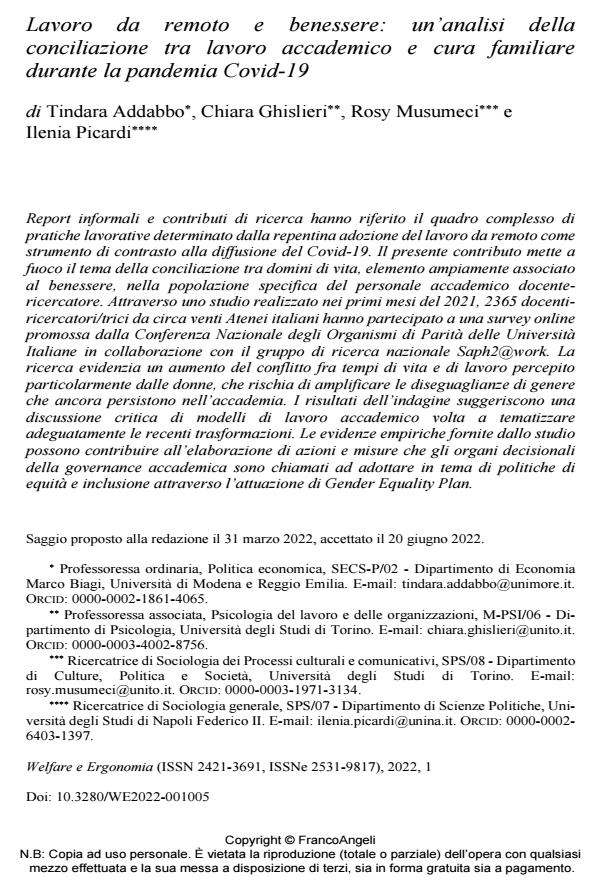Lavoro da remoto e benessere: un’analisi della conciliazione tra lavoro accademico e cura familiare durante la pandemia Covid-19
Titolo Rivista WELFARE E ERGONOMIA
Autori/Curatori Tindara Addabbo, Chiara Ghislieri, Rosy Musumeci, Ilenia Picardi
Anno di pubblicazione 2022 Fascicolo 2022/1
Lingua Italiano Numero pagine 21 P. 41-61 Dimensione file 372 KB
DOI 10.3280/WE2022-001005
Il DOI è il codice a barre della proprietà intellettuale: per saperne di più
clicca qui
Qui sotto puoi vedere in anteprima la prima pagina di questo articolo.
Se questo articolo ti interessa, lo puoi acquistare (e scaricare in formato pdf) seguendo le facili indicazioni per acquistare il download credit. Acquista Download Credits per scaricare questo Articolo in formato PDF

FrancoAngeli è membro della Publishers International Linking Association, Inc (PILA)associazione indipendente e non profit per facilitare (attraverso i servizi tecnologici implementati da CrossRef.org) l’accesso degli studiosi ai contenuti digitali nelle pubblicazioni professionali e scientifiche
Report informali e contributi di ricerca hanno riferito il quadro complesso di pratiche lavorative determinato dalla repentina adozione del lavoro da remoto come strumento di contrasto alla diffusione del Covid-19. Il presente contributo mette a fuoco il tema della conciliazione tra domini di vita, elemento ampiamente associato al benessere, nella popolazione specifica del personale accademico docente-ricercatore. Attraverso uno studio realizzato nei primi mesi del 2021, 2365 docenti-ricercatori/trici da circa venti Atenei italiani hanno partecipato a una survey online promossa dalla Conferenza Nazionale degli Organismi di Pari-tà delle Università Italiane in collaborazione con il gruppo di ricerca nazionale Saph2@work. La ricerca evidenzia un aumento del conflitto fra tempi di vita e di lavoro percepito particolarmente dalle donne, che rischia di amplificare le dise-guaglianze di genere che ancora persistono nell’accademia. I risultati dell’indagine suggeriscono una discussione critica di modelli di lavoro accade-mico volta a tematizzare adeguatamente le recenti trasformazioni. Le evidenze empiriche fornite dallo studio possono contribuire all’elaborazione di azioni e misure che gli organi decisionali della governance accademica sono chiamati ad adottare in tema di politiche di equità e inclusione attraverso l’attuazione di Gender Equality Plan.
Parole chiave:lavoro da remoto; università; benessere; genere; conflitto lavoro-famiglia.
- Pros and Cons of Work Passion: Work-Family Conflict and Insomnia in Academics During the COVID-19 Pandemic Chiara Ghislieri, Domenico Sanseverino, Lara Colombo, Margherita Zito, Paola Spagnoli, Monica Molino, in SAGE Open 21582440251357038/2025
DOI: 10.1177/21582440251357038
Tindara Addabbo, Chiara Ghislieri, Rosy Musumeci, Ilenia Picardi, Lavoro da remoto e benessere: un’analisi della conciliazione tra lavoro accademico e cura familiare durante la pandemia Covid-19 in "WELFARE E ERGONOMIA" 1/2022, pp 41-61, DOI: 10.3280/WE2022-001005